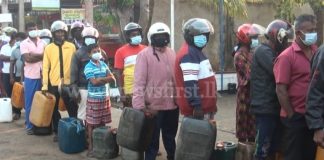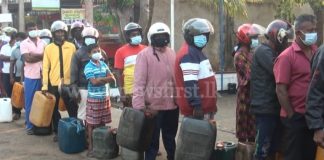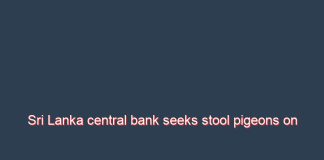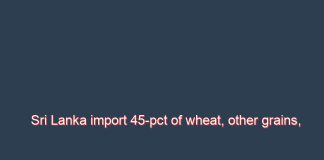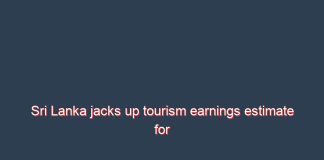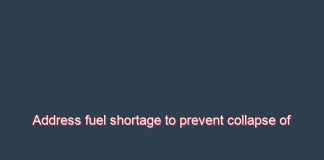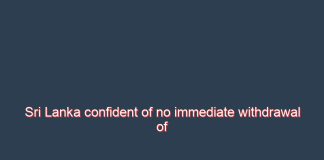Fuel crisis brings Sri Lanka to its knees
Fuel crisis brings Sri Lanka to its knees
Sri Lanka central bank seeks stool pigeons on grey market as...
ECONOMYNEXT – Sri Lanka’s central bank has asked the public to tip the monetary authority on grey market forex dealing as a currency crises triggered by money printed to enforce low interest rates worsened.
“Permission to buy, sell and exchange foreign currency in Sri Lanka is granted ONLY to authorized dealers (i.e. licensed banks) and money changers appointed by the Central Bank of Sri Lanka (CBSL),” the monetary authority said.
“Therefore, foreign currency, shall be purchased, sold or exchanged only through an authorized dealer or an authorized money changer.”
Members of the public, armed with printed rupees, usually paid as salaries to state workers, have turned to unofficial markets for dollars, pushing up parallel exchange rates as there are not enough dollars to match the printed money.
The central bank gave telephone numbers and email addresses for tip-offs.
The full statement is reproduced below:
The Central Bank requests the public to provide information on unauthorized foreign currency dealings
Permission to buy, sell and exchange foreign currency in Sri Lanka is granted ONLY to authorized dealers (i.e. licensed banks) and money changers appointed by the Central Bank of Sri Lanka (CBSL).
Therefore, foreign currency, shall be purchased, sold or exchanged only through an authorized dealer or an authorized money changer.
In terms of the provisions of the Foreign Exchange Act, No.12 of 2017, engaging in foreign currency transactions without permission of CBSL by any person, institution or any other entity is an unlawful activity.
Therefore, if it is noted that any person, institution or any other entity is engaged in unauthorized foreign exchange dealings, the public is hereby requested to inform the Foreign Exchange Department of CBSL via the following telephone numbers or the email address.
Telephone : 0112398827
0112477375
0112398568
Email : [email protected]
Sri Lanka import 45-pct of wheat, other grains, sunflower oil from...
ECONOMYNEXT – Sri Lanka imports 45 percent of wheat, more than half of soybeans, sunflower oil, peas and asbestos are from Russia and Ukraine, which are now in the middle of a war, and mitigation plans may be needed, a Colombo-based think tank said.
Russia and Ukraine are key buyers of Sri Lanka tea and are important sources of tourists.
“Overall, Russia and Ukraine account for 2 percent of Sri Lanka’s imports and 2.2 percent of exports in 2020,” Asanka Wijesinghe, a researcher at Colombo-based Insitute of Policy Studies said in an analysis.
“However, both countries are vital import sources for wheat and export destinations for Sri Lanka’s black tea.”
Russia and Ukraine purchase about 18 percent of fermented black tea exported by Sri Lanka.
About 45 percent of Sri Lanka’s wheat imports came from Russia and Ukraine.
“In addition, more than half of Sri Lanka’s imported soybeans, sunflower oil and seeds, and peas are from Ukraine,” the note said.
“Moreover, Russia and Ukraine are significant import sources for asbestos, semi-finished products of iron and steel, copper(cathodes), and potassium chloride for fertiliser.”
EU, the UK, US and Canada have proposed to cut off several Russian banks from the Swift payment system, which will make it difficult for Russia, in particular, to trade internationally.
Usually, food is exempted from sanctions.
Wijesinghe said rising wheat prices may further push up rice prices.
However, Sri Lanka is now facing forex shortages as the central bank is printing money to keep interest rates down.
As wheat and rice are substitutes, high wheat prices may increase the demand for rice. Thus, it is necessary to remove input shortages like fertiliser to ensure domestic production is adequate.
“Due to the current foreign exchange crisis, Sri Lanka’s ability to effectively face such shocks is constrained,” Wijesinghe said.
“Thus, the urgent priority is to resolve the current foreign exchange crisis to regain the ability to trade swiftly.”
Imports soared to a record 2.2 billion US dollars in December 2021 as the central bank started sterilizing reserves given for imports with new money, a subsidy was given to overseas remittances with printed money and tourism recovered.
Sri Lanka has a dysfunctional pegged exchange rate at 200 to the US dollar with a wide parallel exchange rate and analysts have urged monetary tightening and float to end sterilized intervention and unify the parallel exchange rates.
Sri Lanka is now using reserves for imports, essentially living beyond its means. Sri Lanka last used reserves to extensively intervene at these levels in late 2018. (Colombo/Feb28/2022)
Sri Lanka jacks up tourism earnings estimate for 2021, Jan 2022
ECONOMYNEXT – Sri Lanka has revised up by 142 percent, tourism earnings estimates for January 2022 and also for the full year 2021, based on the average stay and spending from a survey by the tourism promotion office.
Tourism earnings for the full year 2021 were revised up to 633.8 million dollars from a earlier 261.4 million US dollars.
The earnings were revised “based on Sri Lanka Tourism Development Authority survey results on average stay period and average spending per day estimates for 2021,” the central bank said.
Tourism earnings for January 2022 which were originally listed at 110 million US dollars have been revised up to 268.3 million dollars.
The data may be further revised “revised based on Sri Lanka Tourism Development Authority survey results on average stay period and average spending per day estimates for 2022,” the central bank said.
Sri Lanka has blamed the country’s currency crisis on the fall of tourism receipts but analysts have warned that the tourism recovery cannot solve a monetary problem, relating to liquidity injections which has to be solved with higher interest rates.
From October Sri Lanka started using ‘reserves for imports’ (defend the peg for trade transactions), which force the central bank print more money to keep rates down (sterilize the intervention).
Related
Sri Lanka has to hike rates, tourism recovery will not help end forex crisis: Bellwether
To break the cycle of sterilized interventions the rupee should be floated, analysts have said.
Higher tourism earnings will simply generate more imports as the recipients of the money, such as hotel worker, guides and taxi drivers, spend the profits.
There are also operating costs, such as fuel and electricity as well as some foods that are imported to service tourists.
Sri Lanka’s central bank depreciated the currency from 4.70 at the creation of the central bank to 182 to the US dollar in 2019, without Covid or loss of tourism revenues. (Colombo/Feb27/2022)
Transport providers in Sri Lanka struggle to find fuel amid shortage
ECONOMYNEXT – Sri Lanka’s fuel crisis is affecting daily office transport, as service providers are finding it increasingly difficult to keep their buses and vans running, even as private bus owners warn of an imminent collapse of public transport in the country.
A spokesperson for Deepna Transport, a Colombo-based office transport service, told EconomyNext that finding fuel has been a challenge.
‘’I have been in search of fuel all over. I went to around 30 stations to find diesel. I haven’t cancelled anything, nor taken up any work,’’ he said.
Minister of Power Udaya Gamanpila in a parliament session on Wednesday (23) said: “The problem we are facing is not a power or fuel problem. It is the non-availability of dollars.”
He also stated that Sri Lanka would receive 37,500 metric tonnes of diesel worth $35.3 million.
‘’Petrol sheds are rationing what can be given. We need diesel of at least 10,000 rupees to run the daily so when its rationed like this we are wasting time, and the diesel we already have,’’ several transport providers told EconomyNext.
Some fuel stations denied reports that they’re hiding their stocks. “We simply don’t have diesel to provide,’’ one spokesperson said.
However, a fuel station in Talawakele, Kandy, said that due to the shortage, rationing was necessary to make sure that there was enough fuel to go around.
“There are a lot of private buses in this area,” a source told EconomyNext.
“We give each bus around 2,000 to 3,000 rupees worth of petrol, so that they can run the vehicles without stopping. We have to do this because the fuel has to be distributed among everyone as equally as possible since there are very few petrol sheds in the area. ”
“The crisis has scared a few customers and they would pump petrol even if the tanks were full,” he said.
Among the scared consumers are Sri Lanka’s private bus owners.
President of the Lanka Private Bus Owners’ Association Gemunu Wijeratne told reporters on Saturday (26) that the 2,000-rupee cap on the diesel sold to private buses.
“This is not practical, because a bus needs about 6,000 to 7,000 rupees worth of diesel a day to operate short distances. For long distance it’s about 10,000 rupees. This is severely impacting us,” he said.
Warning that by Monday (28) buses may not be able to find diesel at all, Wijeratne said his association plans to inform the Transport Ministry that private bus owners will be compelled to limit their operations whether it’s short distance or long.
“If this continues, public transport will collapse and the economy will come to a standstill,” he said.
Related:
Address fuel shortage to prevent collapse of public transport: Sri Lanka private bus owners
Transporters were expecting shortcomings in fuel and many have taken up tactics to cope with business. Drivers stated that they would go to many different petrol sheds to get a full tank.
‘’I’ve lost diesel by attempting to find diesel! I went to five cities in search of diesel, only to come home to nothing. I have a couple of buses in the network and a few were not able to run today,’’ mentioned Lakshitha, a private transport provider.
He went on to state that several of his passengers had to resort to working from home, and that many had to use public transport to report to work.
‘’There are were more vehicles in petrol sheds rather than on the road,’’ he added.
On Saturday morning, Sri Lanka’s Indian Oil Corporation unit S raised the price of petrol by 20 rupees a litre to 204 rupees and that of diesel by 15 rupees to139 rupees, amid a rise in global prices.
Sri Lanka taxes petrol at higher rate and diesel at a lower rate, despite diesel being more expensive to import. LIOC previously raised petrol to 184rupees to a litre when state-run Ceylon Petroleum Corporation (CPC) held prices at 177 rupees.
The state-run CPC cannot buy enough dollars in the market at the current 200 to the US dollar rate due to foreign exchange shortages. The shortages come from rupees injected into the banking system to maintain low interest rates which it has pushed up credit and demand for all imports.
Energy Minister Udaya Gammanpila has sought a price increase but the cabinet of ministers last week decided not to raise prices.
The CPC says it is losing 551 million rupees a day due to rising fuel prices in February. Unless prices are increased it cannot find the rupees to buy dollars. In the past, losses were covered by tax cuts and loans from state banks. (Colombo/Feb25/2022)
Sri Lanka rupee appreciates against Ruble, sanctions against Russia central bank
ECONOMYNEXT – Sri Lanka’s rupee badly hit liquidity injections, has sharply appreciated to 2.36 rupees to the Russian ruble from 2.66 earlier in the week, after Vladimir Putin invaded Ukraine, and the EU, UK, US and Canada have announced sanctions against Russia’s central bank.
The natural resource rich nation’s central bank is one of the worst in the world and has a strong record of money printing and currency crisis.
The Russian central bank under Tsar Nicholas II in 1905-06 (around Russo-Japanese War) also pioneered modern style exchange controls, after printing money limiting German marks that could be carried out to 50,000 per person.
The inflation created by the Russian central bank during and in the run up to World War I helped bring the Bolshevik’s to power, analysts say. In March 1915 alone the bank printed a billion rubles. By 2017, it was printing 50 million rubles a day.
The Ruble has been steadily falling against the Sri Lanka rupee from around 2.90 rupees October 2021 as the Russian Federation economy recovered and people and companies started to spend money.
Modern interventionist central banks print money to stop credit from slowing and interest rates from going up, triggering currency depreciation and unsustainable imports. When the currency falls, capital flight is triggered, further hitting the currency.
The European Union said it will intensify sanctions against Putin, by barring some Russian banks from using the SWIFT messaging system to clear cross-border transactions and also sanction the central bank in a rare move.
“First, we commit to ensuring that a certain number of Russian banks are removed from SWIFT. It will stop them from operating worldwide and effectively block Russian exports and imports,” Ursula von der Leyen
“Second, we will paralyse the assets of Russia’s central bank. This will freeze its transactions. And it will make it impossible for the Central Bank to liquidate its assets.”
In coordination with I will now propose new measures to EU leaders to strengthen our response to Russia’s invasion of Ukraine and cripple Putin’s ability to finance his war machine. https://t.co/iU2waDzo9s
— Ursula von der Leyen (@vonderleyen) February 26, 2022
Russia’s central bank has been buying large volumes of gold over the last decade as the US Fed printed money and weakened the dollar, pushing up gold and other commodity prices.
The Russian central bank has 2,298 tonnes of gold as of November 2021 the latest available data, against 641 tonnes in March 2020. It has reduced purchases of US securities.
Gold can potentially be shipped to third countries, provided the ship are not arrested mid sea. Western powers have already detained one ship for busting sanctions.
Russia and Ukraine has been the top sources of tourists after the country re-opened for tourism.
Related
Sri Lanka’s tea, tourism, energy, threatened by Ukraine-Russia conflict – analysts
Sri Lanka tourism sector sees cancellations, extensions as Russia-Ukraine conflict intensifies
Russia is also a top buyer of Sri Lanka tea.
Ceylon tea ban lifted after Sri Lanka allows Russian asbestos
In 2020, Sri Lanka imported 232 million dollars of goods from Russia. Sri Lanka imports among other items, asbestos from Russia.
When Sri Lanka banned asbestos imports suddenly, Russia found a beetle in Sri Lanka tea.
Related
Ceylon tea ban lifted after Sri Lanka allows Russian asbestos
Asbestos was banned partly following pressure from the tile lobby, which controls imports to trap the public and push up their profits. (Colombo/Feb27/2022)
Address fuel shortage to prevent collapse of public transport: Sri Lanka...
ECONOMYNEXT – Private bus owners in Sri Lanka have warned of an imminent collapse of public transport in the country if the government does not immediately address fuel shortages.
President of the Lanka Private Bus Owners’ Association Gemunu Wijeratne told reporters on Saturday (26) that filling stations islandwide have imposed a 2,000-rupee cap on the diesel sold to private buses.
“This is not practical, because a bus needs about 6,000 to 7,000 rupees worth of diesel a day to operate short distances. For long distance it’s about 10,000 rupees. This is severely impacting us,” he said.
Warning that by Monday (28) buses may not be able to find diesel at all, Wijeratne said his association plans to inform the Transport Ministry that private bus owners will be compelled to limit their operations whether it’s short distance or long.
“If this continues, public transport will collapse and the economy will come to a standstill,” he said.
On Saturday morning, Sri Lanka’s Indian Oil Corporation unit S raised the price of petrol by 20 rupees a litre to 204 rupees and that of diesel by 15 rupees to139 rupees, amid a rise in global prices.
Sri Lanka taxes petrol at higher rate and diesel at a lower rate, despite diesel being more expensive to import. LIOC previously raised petrol to 184rupees to a litre when state-run Ceylon Petroleum Corporation (CPC) held prices at 177 rupees.
“When there is no fuel at CPC, people go to IOC and pay extra. Bas fares have been calculated for CPC prices. Who is going to bear that loss? At this time, I don’t think we can put that burden on the commuting public,” said Wijeratne.
The state-run CPC cannot buy enough dollars in the market at the current 200 to the US dollar rate due to foreign exchange shortages. The shortages come from rupees injected into the banking system to maintain low interest rates which it has pushed up credit and demand for all imports.
Energy Minister Udaya Gammanpila has sought a price increase but the cabinet of ministers last week decided not to raise prices.
The CPC says it is losing 551 million rupees a day due to rising fuel prices in February. Unless prices are increased it cannot find the rupees to buy dollars. In the past, losses were covered by tax cuts and loans from state banks.
Related:
Why Sri Lanka is having power cuts, fuel shortages as forex crisis worsens – Explained
Meanwhile, Chairman of the All Ceylon Private Bus Owners Association Anjana Priyanjith told reporters Saturday morning that the government must immediately provide a diesel concession for the sector.
“In the absence of an alternative, bus owners will be compelled to revise bus fares by a higher percentage,” he said.
“Spare part prices are also rapidly increasing, as are repair costs and the price of tyre tube tapes. But our daily income remains the same,” he said. (Colombo/Feb26/2022)
Fisherfolk from across Sri Lanka protest alleged Indian poaching
ECONOMYNEXT – Fisherfolk from across Sri Lanka stood in solidarity with their peers in the north on Thursday (23), protesting what they called illegal fishing by Indian nationals in Sri Lankan waters.
Fishermen from 18 districts took part in a protest held outside the Fort Railway Station and marched to the Lipton Circus nearby calling for an end to the alleged poaching and outlawed practices such as bottom-trawling.
The protest was organised by the National Fisheries Solidarity Movement.
T H Harrison (70), a fisherman from Dodanduwa, Galle, told EconomyNext that the repercussions of the Indian poaching are not limited to the island’s northern waters.
“The situation in India is not only affecting the North. Fishermen in the south are suffering too. Fish migrate around the island, and when the Indians with their big boats come and take all the fish, there won’t be any fish left for us,” said Harrison.
Mackerel, squid and big-eyed scads were among the depleting types of fish, he said.
Northern fishermen have been complaining of Indian poaching for years now, with Sri Lankan authorities routinely making arrests of Indian fishermen and confiscating their boats and equipment.
Fishing vessels from South India had gotten into the habit of straying over the Indo-Lanka maritime border during Sri Lanka’s 26-year civil war when Sri Lankan fishermen were banned from entering the Northern waters. Over a decade since the end of the war, boats from South India continue to frequently cross the Palk Strait, creating a sensitive diplomatic issue between the two South Asian countries.
Harris spoke to EconomyNext of the illegal fishing methods used by powerful merchants that put small scale fishermen in trouble.
“They use light-tackle fishing, which is illegal. There isn’t enough fish to breed properly because these big fishermen come and catch them all.”
Light force fishing, which is considered an illegal poaching method in Sri Lanka, is the process of submerging powerful lights underwater to attract fish to the surface to capture them into massive nets. Light force fishing is a major contributor to bycatch or the practice of throwing out unsuitable fish or unwanted breeds after they have been caught.
The large number of young fish captured in this manner depletes the gene pool and results in scarcity.
However, Captain De Silva, Media Spokesperson for the Sri Lankan Navy said, ‘’Light fishing is not the issue; it’s bottom trawling by fishermen.’’
Bottom trawling, a method practised by Indian fishermen is a method of fishing that uses large nets that are dragged across the seabed, capturing all fish in the vicinity, and ripping up the seabed.
Bottom trawling and overfishing by South Indian fishermen resulted in the depletion of marine resources in the Indian Ocean Territory, inducing the fishermen to travel to Sri Lankan waters for fish.
While this went on undisturbed during the Sri Lankan civil war, major disputes have been occurring since Northern Sri Lankan fishermen started going back to sea.
The Tamil National Alliance (TNA) has called for legal action. TNA parliamentarian M A Sumanthiran told EconomyNext that the crisis can be minimised if Sri Lankan authorities continue to arrest poachers.
According to Business Standard, an Indian Daily, 66 Indian fishermen who were poaching in Sri Lankan waters have been arrested in February and 10 trawlers have been seized by the Sri Lankan Navy.
On February 07, the Sri Lankan government auctioned off over a hundred boats that were seized by the Navy over the years.
In addition, alleged assaults of Indian fishermen by Sri Lankans have served to increase tensions.
With small boats that were unable to keep up with the massive trawlers from South India, many Northern fishermen have changed livelihoods to farm sea cucumbers instead, a delicacy in most of East and South-East Asia.
China, a large consumer of sea cucumbers, have been aiding these farmers in their efforts.
Sri Lanka’s northern fishermen switch to China-backed sea cucumber boom
However the demand for this delicacy has resulted in even more poaching in the Indo Sri Lankan waters, with authorities in Sri Lanka and India seizing nearly 65 metric tons of sea cucumbers worth more than 2.8 million US dollars between 2015 and 2020. Over 500 people were arrested in that period in connection with the attempted trafficking.
“At the end of the day, we are protesting not for us but our children. They are the ones who will continue this profession. We don’t have anything to eat; our livelihoods have been taken from us; and nobody cares,” said Harris.
“All we ask is that these illegal activities are stopped so that fisherfolk around Sri Lanka can continue their work in peace.” (Colombo/Feb26/2022)
Sri Lanka confident of no immediate withdrawal of EU’s GSP Plus...
ECONOMYNEXT – Sri Lanka is confident that the European Union will not withdraw the lucrative GSP Plus trade concession immediately as it has already addressed some concerns raised by the block on human rights, Foreign Ministry Secretary Jayanath Colombage said.
The Generalised Scheme of Preferences (GSP) Plus – an annual trade concession worth over 500 million US dollars – has boosted Sri Lanka’s exports to EU member states. Sri Lanka lost access to GSP Plus in 2010 due to alleged human rights violations but regained it in 2016 after pledging to implement 27 international conventions.
However, Sri Lanka has failed to implement several commitments it had made to the EU and the bloc has warned that the concession could be withdrawn if the island nation fails to implement a few key demands including the repeal of the Prevention of Terrorism Act (PTA) and the release of long detained suspects under the PTA.
“We are fairly confident that the GSP Plus will not be withdrawn immediately because we have provided very credible, genuine answers to the queries made by the EU Commission,” Colombage told a media conference ahead of his visit to face United Nations Human Rights Council sessions starting on Monday (28) in Geneva.
“One of the main focuses of the EU was the PTA. Now we have done the amendment and it is before the parliament. Hopefully, on the 8th or 9th of the next month, it will become the law of the country. So that is the concrete positive step we have taken.”
“They were also very concerned about long term returnees. Eighty-one detainees are already released and we will release more. Because this is all Sri Lankans languishing in a jail somewhere and it is not fair to keep them any longer.”
A loss of GSP+ will be a huge blow to cash-strapped Sri Lanka which is facing an unprecedented economic and debt crisis. The concession has helped Sri Lanka earn more US dollars at a time the island nation cannot borrow from international capital markets due to a series of rating downgrades by global rating agencies.
Foreign Minister G L Peiris has tabled the amendment in parliament though a debate has yet to be scheduled. Though government critics say the move was to hoodwink the international community ahead of the next week UNHRC session and prevent the loss of GSP+, some government officials say the amendment will dilute the power of authorities to detain suspects for a long period.
“So we are confident that we will have the GSP Plus for a while. But it does not mean that we should take it lightly. We have to work very hard. We have to address the concerns and issues so that we will continue to derive the GSP Plus continuously.”
Colampage said the GSP+ has really helped fishermen, garment factories, and farmers more than the government.
“And if it is withdrawn, these will be the worst affected categories,” he said. (Colombo/Feb25/2022)
